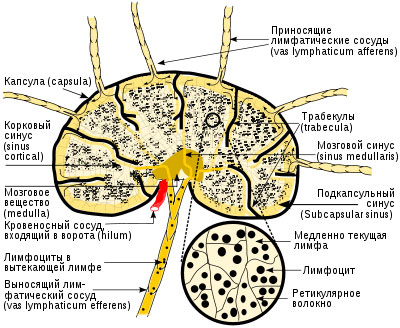The structure and function of a lymph node
Normal lymph nodes - This round, oval or bean-shaped formation, coated capsule, is a dense connective tissue sheath with a dash neischerchennyh (smooth) muscle fiber, which makes it possible to shrink lymph node and actively promote lymph.
From the capsule into the interior depart lymph node crossbar, that, connecting, form the backbone node. In the concave portion of the assembly are gate, of which the efferent lymph vessel goes through and which node penetrate blood vessels and nerves. On the opposite, convex, side to a lymph node-bearing lymph flow lymph vessels, that form subcapsular (edge) sinuses of lymph node. Angular them, between trabeculae, arranged between an anastomosing vokruguzelkovye sinusy. The walls of the sinuses are lined with reticular cells, which have a high phagocytic activity.
The spaces between the sinuses filled with a network of reticular fibers, at intersections lie reticular cells. The hinges reticulum are lymphoid cells, Body components of parenchyma. In the parenchyma of the lymph nodes are distinguished cortex and medulla and paracortical zone.
Cortex located at the boundary (subcapsular) Sinus, there are thimic-independent B-lymphocytes. It consists of lymph nodules (follicles) diameter of 0,5 to 1,0 mm. In the center of the follicles are large cells with large nuclei (macrophages, lymphoblasts and dendritic retikulopodobnye, or Process, cell). Some of these cells is in a state of division, Hence arose the earlier name of the breeding center.
In cases of an infectious disease, especially bacterial, in the follicles of the lymph nodes may appear a large number of macrophages, that was the basis for the names of such follicles reactive centers. Dendritic cells, According to modern ideas, They are a type of macrophages, capable of fixing immunoglobulins, and through them the antigens. After antigen-antibody reaction, they are contacted with lymphocytes.
Cortex is responsible for the production of humoral antibodies. Reactive centers are surrounded by follicular area closely surrounding small lymphocytes.
On the border between the cortex and medulla is located parakortikalynaya area. In this zone thymus-dependent lymphocyte proliferation (T-lymphocyte) and their blast transformation. Between lymphocytes are post-capillary venules, through which lymph node penetrate circulating lymphocytes.
Medulla presented myakotnыmy strands, which anastomose with each other. They are home to the proliferation of B-lymphocyte. Besides, Here are prolymphocytes, macrophages and plasma cells in state of proliferation and maturation.
Lymph nodes are involved in haemopoiesis, It is lymfotsytoobrazuyuschymy bodies. They are involved in the defense response, performing the role of a biological filter, which delayed and phagocytized foreign particles and bacteria. Organisms, Hitting in the lymph nodes, usually die, but if they pass through this barrier, it has a significantly reduced virulence. Lymph nodes are involved in the immune response: They occur in all the reactions of specific (humoral and cell) immunity.
In the midst of the digestive system, when the inflow of lymph from the intestines of more than roomy opportunities thoracic duct, Lymph nodes can be deposited lymph increasing the. By reducing muscle cells neischerchennoy capsules and bars provide movement of lymph nodes lymph. Besides, lymph nodes are involved in the metabolism of fat in the body. This applies particularly to the mesenteric lymph nodes, that receives the rich lymph from the intestines of fat.

